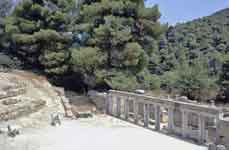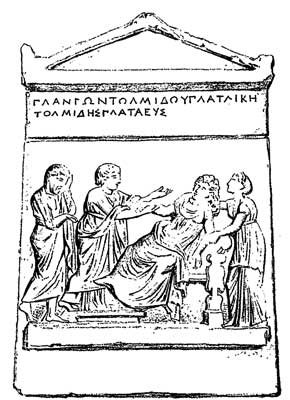Ὠρωπός, πόλις Μακεδονίας, ἐξ ἧ Σέλευκος ὁ Νικάτωρ. καὶ ἄλλη Βοιωτίας, περὶ ἧς Εὐφορίων Κλείτορι Αὐλίς τ´ Ὠρωπός τε καὶ Ἀμφιάρεια λοετρά. κέκληται ἀπὸ Ὠρωποῦ τοῦ Μακεδόνος τοῦ Λυκάονος. [ἔστι καὶ ἄλλη Εὐβοίας.] Ἀριστοτέλης γοῦν τὸν Ὠρωπὸν Γραῖάν φησι λέγεσθαι ἡ δὲ Γραῖα τόπος τῆς Ὠρωπίας πρὸς τῇ θαλάσσῃ κατ´ Ἐρέτριαν τῆς Εὐβοίας κειμένη. ἔστι καὶ τρίτη ἐν Συρίᾳ, κτισθεῖσα ὑπὸ Νικάτορος, περὶ ἧς ὁ πολυΐστωρ ἐν τῷ περὶ Συρίας φησὶν οὕτως Ξενοφῶν ἐν ταῖς ἀναμετρήσεσι τῶν ὀρῶν περὶ Ἀμφίπολιν κεῖσθαι πόλιν Ὠρωπόν, ἣν πρότερον Τελμησσὸν καλεῖσθαι ὑπὸ τῶν κτισάντων. ταύτην δέ φασιν ὑπὸ Σελεύκου τοῦ Νικάτορος ἐπικτισθεῖσαν Ὠρωπὸν ὠνομάσθαι ἀπὸ τῆς ἐν τῇ Ἑλλάδι Ὠρωποῦ. ἔστιν οὖν καὶ τετάρτη πόλις ἐν Ἄργει ὕστερον κτισθεῖσα. καὶ πέμπτη ἐν Θεσπρωτίᾳ [ἤγουν ἐν Νικοπόλει]. λέγεται καὶ ἀρσενικῶς. Θουκυδίδης ὀγδόῃ ἔχοντες οὖν τὸν Ὠρωπὸν ἀφικνοῦνται εἰς τὴν Ῥόδον. τὸ ἐθνικὸν Ὠρωπεύς· οὕτως γὰρ ὡς αὐτὸς ἐν νεῶν καταλόγου πρώτῃ ἔστι δ´ ἡ Γραῖα τόπος, τῶν Ὠρωπέων πόλις. Στράβων δ´ ἐν τῇ ἐνάτῃ φησίν ἀπὸ τῆς Ὠρωπίας ἐπὶ τὴν δύσιν, ὡς ἀπὸ τοῦ Ὠρώπιος· εἰ γὰρ ἦν ἀπὸ τοῦ Ὠρωπιεύς, Ὠρωπιάς ἂν εἶπε. Παυσανίας δὲ ἐν τῷ ἑβδόμῳ τὴν μὲν πόλιν θηλυκῶς φησι διαρπάζουσιν Ὠρωπὸν ὑπήκοόν σφισιν οὖσαν, τὸ δ´ ἐθνικὸν οὕτως καταφεύγουσιν ἐπὶ τὴν Ῥωμαίων βουλὴν οἱ Ὠρώπιοι. καὶ Θουκυδίδης δευτέρᾳ παριόντες Ὠρωπὸν τὴν γῆν Γραϊκὴν καλουμένην, ἣν νέμονται Ὠρώπιοι Ἀθηναίων ὑπήκοοι, ἐδῄωσαν. καὶ Θεόπομπος ϛʹ Ἑλληνικῶν ἀνακοινοῦνται τῶν Ὠρωπίων Τηλέφῳ καὶ τοῖς μετ´ ἐκείνου βουλομένοις καὶ τὸν Ὠρωπὸν ὑπάρχειν αὐτοῖς. Stephanus of Byzantium
Oropus or Oropos (Ancient Greek: ὁ Ὠρωπός, or rarely ἡ Ὠρωπός[1]) was a town on the borders of ancient Attica and Boeotia, and the capital of a district, called after it Oropia (ἡ Ὠρωπία.) This district is a maritime plain, through which the Asopus flows into the sea, and extends for 5 miles (8.0 km) along the shore. It is separated from the inland plain of Tanagra by some hills, which are a continuation of the principal chain of the Diacrian mountains. Oropus was originally a town of Boeotia; and, from its position in the maritime plain of the Asopus, it naturally belonged to that country.[2] It was, however, a frequent subject of dispute between the Athenians and Boeotians; and the former people obtained possession of it long before the Peloponnesian War. It continued in their hands till 412 BCE, when the Boeotians recovered possession of it.[3] A few years afterwards (402 BCE) the Boeotians, in consequence of a sedition of the Oropians, removed the town 7 stadia from the sea.[4] During the next 60 years the town was alternately in the hands of the Athenians and Boeotians,[5] till at length Philip II of Macedon after the Battle of Chaeronea (338 BCE) gave it to the Athenians.[2] In 318 BC the Oropians recovered their liberty.[6] In 312 BCE Cassander obtained possession of the city; but Polemon, the general of Antigonus, soon afterwards expelled the Macedonian garrison, and handed over the city to the Boeotians.[7] It has been concluded from a passage of Dicaearchus that Oropus continued to belong to Thebes in the next century; but the expression οἰκία Θηβῶν is corrupt, and no safe conclusion can therefore be drawn from the passage.[8] Dicaearchus calls the inhabitants Athenian Boeotians, an epithet which he also applies to the inhabitants of Plataeae. Strabo also describes Oropus as a Boeotian town;[9] but Livy,[10] Pausanias,[2] and Pliny the Elder[11] place it in Attica. How long the Oropians inhabited the inland city is uncertain. Pausanias expressly says that Oropus was upon the sea;[12] and the inhabitants had probably returned to their old town long before his time.

Although Oropus was so frequently in the hands of the Athenians, its name is never found among the Athenian demoi. Its territory, however, if not the town itself, appears to have been made an Attic demus under the name of Graea (ἡ Γραῖα). In Homer Oropus does not occur, but Graea is mentioned among the Boeotian towns;[13] and this ancient name appears to have been revived by the Athenians as the official title of Oropus. Aristotle said that Oropus was called Graea in his time;[14] and accordingly we find in an inscription, belonging to this period, the people of Graea (Γραῆς or Γραεῖς) mentioned as a deme of the tribe Pandionis.[15]

Plangon Stele: Text; Plangon Tolmidoy Plataiki. Tolmides Plataeus. "Plangon, wife of Tolmides, from Plataea. Tolmides, the Platean". Probably the stele of a wife who died soon a after becoming a mother. Discovered in Oropos. Athens, Athens National Archaeological Museum; NM 749
According to Dicaearchus, the Oropians were notorious for their grasping exactions, levied upon all imports into their country,[8] and were for this reason satirised by Xenon, a comic poet: "Πάντες τελῶναι, πάντες εἰσὶν ἅρπαγες. Κακὸν τέλος γένοιτο τοῖς ᾿Ωρωπίοις."
The position of Oropus is thus described by Strabo: "The beginning [of Boeotia] is Oropus, and the sacred harbour, which they call Delphinium, opposite to which is old Eretria in Euboea, distant 60 stadia. After Delphinium is Oropus at the distance of 20 stadia, opposite to which is the present Eretria, distant 40 stadia. Then comes Delium."[16]
The modern village of Oropos stands at the distance of nearly two miles (3.2 km) from the sea, on the right bank of the Asopus: it contains some fragments of ancient buildings and sepulchral stones. There are also Hellenic remains at Skála (Σκάλα) or wharf upon the bay, from which persons usually embark for Euboea: this place is also called ἐς τοὺς ἁγίους ἀποστόλους, from a ruined church dedicated to the Holy Apostles. William Martin Leake originally placed Oropus at Oropos and Delphinium at Skála; but in the second edition of his Demi he leaves the position of Oropus doubtful. It seems, however, most probable that Oropus originally stood upon the coast, and was removed inland only for a short time. In the Peloponnesian War Thucydides speaks of sailing to and anchoring at Oropus;[17] and Pausanias, as we have already seen, expressly states that Oropus was upon the coast. Hence there can be little doubt that Skála is the site of Oropus, and that Oropos is the inland site which the Oropians occupied only for a time. It is true that the distance of Oropos from the sea is more than double the 7 stadia assigned by Diodorus, but it is possible that he may have originally written 17 stadia. If Oropus stood at Skála, Delphinium must have been more to the eastward nearer the confines of Attica. Modern scholars accept the site of Skála, now called Skala Oropou after the ancient town.[18][19]
In the territory of Oropus was the celebrated temple of the hero Amphiaraus (Amphiareion of Oropos). According to Pausanias, it was 12 stadia distant from Oropus.[2] Strabo places it in the district of Psophis, which stood between Rhamnus and Oropus, and which was subsequently an Attic deme.[20] Livy calls it the temple of Amphilochus,[10] who, we know from Pausanias, was worshipped conjointly with Amphiaraus. Livy further describes it as a place rendered agreeable by fountains and rivers. Dicaearchus describes the road from Athens to Oropus as leading through bay-trees (διὰ δαφνίδων) and the temple of Amphiaraus.[8]
See also
List of ancient Greek cities
References
Pausanias. Description of Greece. 7.11.4.
Pausanias. Description of Greece. 1.34.1.
Thucydides. History of the Peloponnesian War. 8.60.
Diodorus Siculus. Bibliotheca historica (Historical Library). 14.17.
Xenophon. Hellenica. 7.4.1. et seq.
Diodorus Siculus. Bibliotheca historica (Historical Library). 18.56.
Diodorus Siculus. Bibliotheca historica (Historical Library). 19.77.
p. 11, ed. Hudson
Strabo. Geographica. ix. p. 404. Page numbers refer to those of Isaac Casaubon's edition.
Livy. Ab Urbe Condita Libri (History of Rome). 45.27.
Pliny. Naturalis Historia. 4.7.11.
ἐπὶ θαλάσσης, Pausanias, 1.34.1.
Homer. Iliad. 2.498.
ap. Stephanus of Byzantium. Ethnica. sub voce Ὠρωπός.
Ross & Meier, Die Demen von Attika, p. 6, et seq.
Strabo. Geographica. ix. p.403. Page numbers refer to those of Isaac Casaubon's edition.
Thucydides. History of the Peloponnesian War. 3.91. , 8.95.
Lund University. Digital Atlas of the Roman Empire.
Richard Talbert, ed. (2000). Barrington Atlas of the Greek and Roman World. Princeton University Press. p. 59, and directory notes accompanying.
Strabo. Geographica. ix. p. 399. Page numbers refer to those of Isaac Casaubon's edition.
This article incorporates text from a publication now in the public domain: Smith, William, ed. (1854–1857). "Oropus". Dictionary of Greek and Roman Geography. London: John Murray.ac
A - B - C - D - E - F - G - H - I - J - K - L - M-
N - O - P - Q - R - S - T - U - V - W - X - Y - Z
Retrieved from "http://en.wikipedia.org/"
All text is available under the terms of the GNU Free Documentation License
| Ancient Greece
Science, Technology , Medicine , Warfare, , Biographies , Life , Cities/Places/Maps , Arts , Literature , Philosophy ,Olympics, Mythology , History , Images Medieval Greece / Byzantine Empire Science, Technology, Arts, , Warfare , Literature, Biographies, Icons, History Modern Greece Cities, Islands, Regions, Fauna/Flora ,Biographies , History , Warfare, Science/Technology, Literature, Music , Arts , Film/Actors , Sport , Fashion --- |

